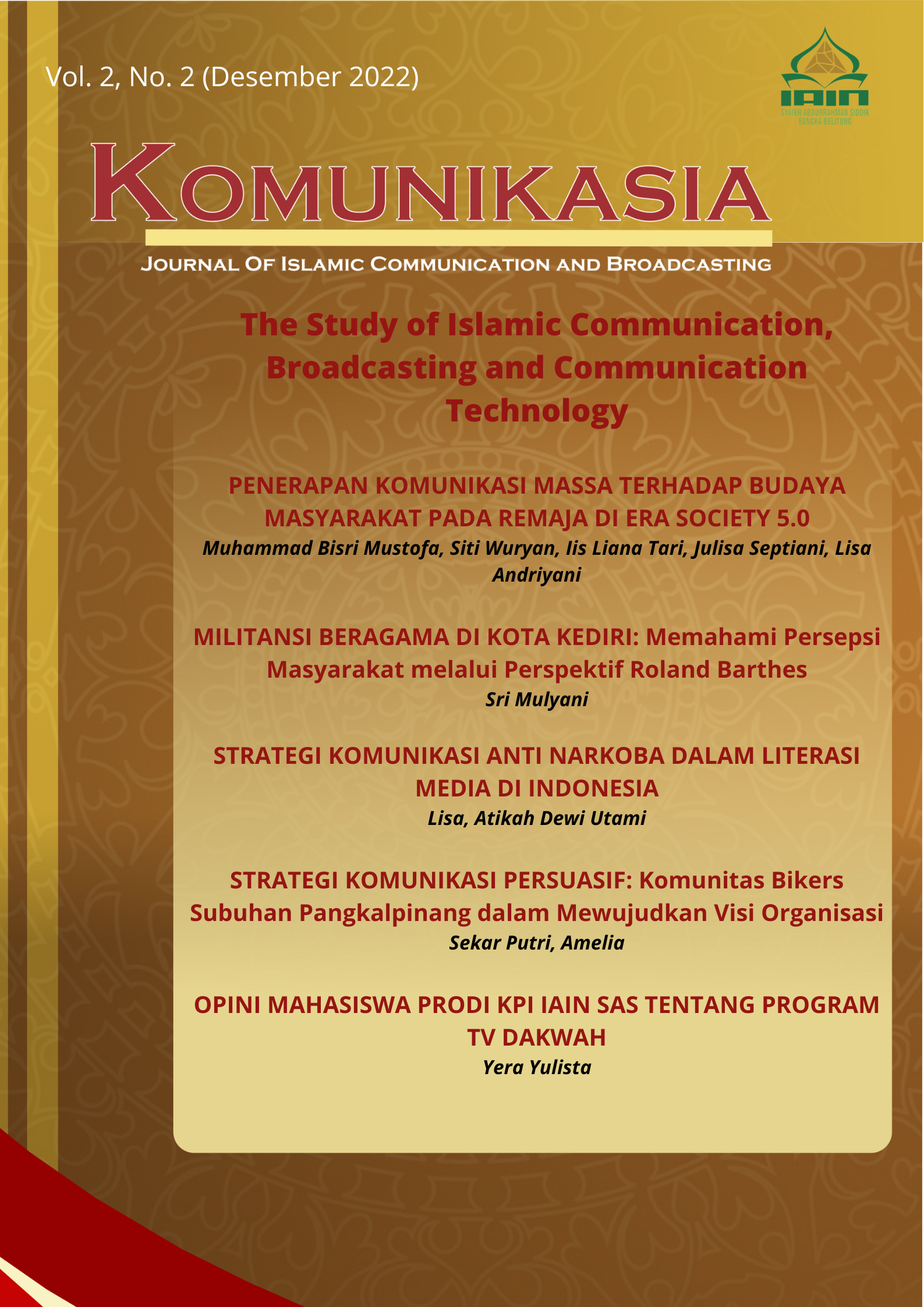PENERAPAN KOMUNIKASI MASSA TERHADAP BUDAYA MASYARAKAT PADA REMAJA DI ERA SOCIETY 5.0
Abstract
The condition of social media is now able to fully encourage social interaction and all community activities. The influence of mass communication (cognitive, affective, and behavioral) for users or social media audiences where their behavior has been positively and negatively influenced. This condition is very concerning because the socio-culture of teenagers has been influenced by the mass media which seems to have become the basic need of teenagers. The mass media should be consumed according to need, in fact now the mass media has become a basic need that has been able to fulfill and assist all daily activities. However, as a teenager in his time, he should still be controlled and need supervision. This study focuses on how the influence/effect of mass communication on audiences who use social media on teenagers in the 5.0 era of society. Adolescence is the start of the change between childhood and adulthood, which is still influenced by the mass media in this 5.0 era of society. Researchers used library research methods using various library sources or previously written works. From the results of this study, the greatest effect of social media on adolescents is a change in attitudes and behavior in the social and cultural sphere. Therefore, the social effects of mass communication on teenagers are like 2 sides of a coin that have good and bad effects, so due to the mass media today, everything that teenagers do sometimes cannot be controlled and still cannot be considered good or bad for themselves.
Downloads
References
Dani, J. A., dan Y. Mediantara. “Covid-19 dan Perubahan Komunikasi Sosial.” Persepsi: Communication Journal, 2020. http://jurnal.umsu.ac.id/index.php/PERSEPSI/article/view/4510.
Fatma, Oleh, and Laili Khoirun. “Persuasi dalam Media Komunikasi Massa,” n.d., 77–95.
Fitriansyah Program Studi Penyiaran Akademi Komunikasi BSI Jakarta, Fifit, and Cara Sitasi. “Efek Komunikasi Massa Pada Khalayak (Studi Deskriptif Penggunaan Media Sosial Dalam Membentuk Perilaku Remaja).” Cakrawala 18, no. 2 (2018): 171–78. http://ejournal.bsi.ac.id/ejurnal/index.php/cakrawalahttps://doi.org/10.31294/jc.v18i2.
Fitriansyah Program Studi Penyiaran Akademi Komunikasi BSI Jakarta, Fifit, dan Cara Sitasi. “Efek Komunikasi Massa Pada Khalayak (Studi Deskriptif Penggunaan Media Sosial dalam Membentuk Perilaku Remaja).” Cakrawala 18, no. 2 (2018): 171–78.
Irsa, “Kementerian Komunikasi dan Informatika.” Diakses 24 Mei 2022. https://www.kominfo.go.id/content/detail/30653/dirjen-ppi-survei-penetrasi-pengguna-internet-di-indonesia-bagian-penting-dari-transformasi-digital/0/berita_satker.
Lestari, D., D. Norrahmi, dan ... “Peran Media Komunikasi dalam Upaya Edukasi Tentang Pentingnya Vaksin Sinovac Untuk Mencegah Penularan Covid-19 (Studi Kasus Pada Masyarakat Wilayah ….” … Indonesia Sosial Sains, 2021. http://jiss.publikasiindonesia.id/index.php/jiss/article/view/374.
Madyawati, Lilis, Marhumah Marhumah, dan Ahmad Rafiq. “Urgensi Nilai Agama Pada Moral Anak Di Era Society 5.0.” Al-Hikmah: Jurnal Agama dan Ilmu Pengetahuan 18, no. 2 (2021): 132–43. https://doi.org/10.25299/al-hikmah:jaip.2021.vol18(2).6781.
Marlina. “Pengaruh Komunikasi Massa Dan Media Terhadap Masyarakat Dan Budaya.” Http://Jurnal.Pancabudi.Ac.Id/Index.Php/Alhadi/ Vol.03, No, no. http://jurnal.pancabudi.ac.id/index.php/alhadi/article/view/355 (2018): 685–97.
Munardi, Benny. “Efek Media Massa Terhadap Agama dan Kehidupan Sosial Budaya Dalam Pembentukan Moral Dan Kepribadian Masyarakat.” Journal Waraqat VI, no. 2 (2021): 74–83.
Mustofa, M. B., A. Sujepri, U. Mutoharoh, dan ... “Efek Perkembangan Komunikasi Massa Terhadap Pola Pikir dan Perilaku Masyarakat Di Era Society 5.0.” … Dan Penyiaran Islam. ejournal.iai-tabah.ac.id, 2022. http://ejournal.iai-tabah.ac.id/index.php/alamtaraok/article/download/907/632.
Nainggolan, Vitri, Sintje A Rondonuwu, dan Grace J Waleleng. “Peranan Media Sosial Instagram Dalam Interaksi Sosial Antar Mahasiswa Fakultas Ilmu Sosial Dan Politik Unsrat Manado,” t.t., 15.
Ngafifi, Muhamad. “Kemajuan Teknologi dan Pola Hidup Manusia Dalam Perspektif Sosial Budaya.” Jurnal Pembangunan Pendidikan: Fondasi dan Aplikasi 2, no. 1 (1 Juni 2014). https://doi.org/10.21831/jppfa.v2i1.2616.
Nikijuluw, Gabriella Marysca Enjel, Ari Rorong, dan Very Y Londa. “Perilaku Masyarakat Di Era Digital (Studi Di Desa Watutumou Iii Kecamata Kalawat Kabupaten Minahasa Utara),” t.t., 12.
Nugraha, M. R., dan S. W. Herieningsih. “Hubungan Terpaan Berita Covid-19 Di Media Massa Dan Tingkat Kecemasan Dengan Perilaku Hidup Bersih Dan Sehat Pada Remaja.” Interaksi Online, 2020. https://ejournal3.undip.ac.id/index.php/interaksi-online/article/view/29578.
Octafitria, Yofita. “Media Sosial Sebagai Agen Sosialisasi Politik Pada Kaum Muda.” Indonesian Journal of Sosciology and Education Policy 1, no. 1 (2018): 22.
Rouf, Ahmad. “Reaktualisasi dan Kontekstualisasi Kearifan Lokal dengan Manhaj Global: Upaya menjawab problematika dan tantangan pendidikan di era Society 5.0 dan Revolusi Industri 4.0.” Seminar Nasional Pascasarjana 2019, 2019, 910–14.
Sarkawi, Dahlia. Perubahan Sosial dan Budaya Akibat Media Sosial. Jurnal Administrasi Kantor. Vol. 4, 2016.
Sudrajat, T., dan L. Rohida. “Efek Media Massa dalam Pembentukan Opini Publik di Masa Pandemi Covid-19.” Prosiding Seminar Nasional Ilmu Sosial dan …, 2022. https://mail.pbtv.co.id/index.php/prosiding/article/view/5329.
Xiao, Angeline. “Konsep Interaksi Sosial Dalam Komunikasi, Teknologi, Masyarakat.” Jurnal Komunika : Jurnal Komunikasi, Media dan Informatika 7, no. 2 (11 Oktober 2018). https://doi.org/10.31504/komunika.v7i2.1486.
Yoga, Salman. “Perubahan Sosial Budaya Masyarakat Indonesia Dan Perkembangan Teknologi Komunikasi.” Jurnal Al-Bayan 24, no. 1 (2019): 29–46. https://doi.org/10.22373/albayan.v24i1.3175.
Yurikasari, Devy. “Konten Youtube Tasya Farasya Terhadap Gaya Hidup Hedonis Mahasiswa Fisip Universitas Mulawarman,” t.t., 11.
Copyright Notice
Komunikasia: Journal of Islamic Broadcasting and Communication is under the Creative Commons Attribution 4.0 International (CC-BY 4.0) License, according to which:
1) Authors retain copyright and grant the journal the right to first publication, with the work simultaneously licensed under the Creative Commons Attribution (CC-BY 4.0) that allows the sharing of articles published with the acknowledgment of authorship and the initial publication in this journal.
2) The authors are authorized to make additional contracts separately for distribution of the version of the work published in this journal (for example, publication in an institutional repository or as a chapter of the book), as long as there is recognition of authorship and initial publication in this journal.
3) Authors are authorized and encouraged to publish and distribute their work online (for example, in institutional repositories or on their personal pages) at any time before or during the editorial process, as it increases the impact and reference of the published work.



















